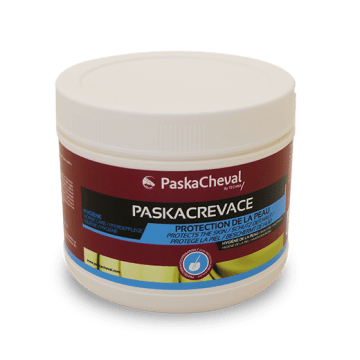The frog is an essential component to ensure the correct function of the hoof. In the most critical cases, poor frog conditions can jeopardise the health of the horse’s whole locomotor system. How can you take care of your horse’s frog and prevent fungal problems?
Structure and role of the frog
The frog is an essential component of your horse’s hoof. It can be easily identified by its V-shape. It consists of spongy, elastic tissue, demarcated by a central groove and two collateral grooves.
Underneath the frog is the digital cushion, also known as the plantar cushion. This cushion absorbs vertical shocks and redistributes them horizontally to the entire hoof wall. Its role is to protect the horse’s joints as much as possible.
What are the causes and consequences of frog thrush?
Although some people dispute its essential role, a frog that is in poor condition very often causes horses to be lame. Whether in shod or unshod horses, lameness can be a direct result of poor frog condition. Lameness can also have medium to long-term effects on a horse’s joints and tendons.
In the majority of cases, frog thrush is related to the development of anaerobic bacteria, such as Fusobacterium necrophorum. These develop in environments without oxygen. An accumulation of bedding can therefore promote their development. These bacteria cause rotting of the frog, giving off a foul odour. The frog turns black, with flaps of flesh caused by its decomposition. The damage can extend as far as the heels and cause hoof contraction. This leads to atrophy of the frog, the grooves get deeper and the heels tighten very often causing lameness and requiring specific horseshoes to be fitted. This thrush should not be confused with “canker”, which is a chronic pododermatitis (an infectious disease of the foot not related to frog thrush).
How can frog thrush be prevented?
It is possible to prevent the risk of thrush in the frogs of horses by applying a few specific hygiene rules:
- Keep bedding as clean as possible. An effective solution is to clean it regularly using a bedding conditioner. This prevents excessive humidity by trapping water and ammonia from urine.
- Regularly perform hoof care. Cleaning out all the grooves of the frog and using ointments and oils suited to the climate conditions and the condition of the hoof also help keep frogs healthy.
- Regular trimming by a farrier also helps ensure hoof condition is regularly monitored.
If the frog begins to rot, it is essential to clean it daily. The use of specific disinfecting and drying products on the frog is also recommended, to directly stop the thrush spreading.
Our Paskabox and Frog Protec solutions help to keep frogs healthy. Our Paskacheval range is made up of products specially designed to maintain the overall health of your horse’s locomotor system. Find all our products at your nearest distributor.
Where to find Paskacheval products?
Find your nearest sales outlet
Paskacheval is a range of plant-based feed supplements and external care products designed to enhance the performance and well-being of every horse.


